Petra Rock Climbing: Techniques, Culture & Gear


Intro
Petra, a UNESCO World Heritage site, is not only famous for its stunning archaeological wonders but also for its captivating rock climbing terrain. Nestled in the heart of southern Jordan, Petra offers climbers a unique experience with its intricate rock formations and rich cultural history.
This article delves into the nuances of rock climbing in Petra, providing insights into the techniques, culture, and gear that are vital for both novices and seasoned climbers. We will uncover the challenges posed by the environment, the importance of safety measures, and the ethical considerations necessary for responsible climbing practices.
Understanding Petra's climbing landscape goes beyond merely reaching the top; it involves appreciating the site's historical significance and engaging with local communities. Join us as we explore the exhilarating world of rock climbing in this remarkable location.
Techniques and Tips
Skill Development
To thrive in Petra's unique climbing environment, developing a solid foundation in climbing skills is crucial. Emphasis should be placed on bouldering and sport climbing, as these techniques are particularly suited to the region's rock types. Climbers should prioritize mastering footwork, grip techniques, and body positioning to navigate the diverse routes.
Practical Techniques
The terrain in Petra presents various challenges, including loose rock and unique formations that require creative climbing solutions. Here are some practical techniques to improve your climbing:
- Balance and Body Control: Maintaining balance is key, especially on sloping surfaces.
- Route Reading and Planning: Before starting a climb, assess the route to determine the best holds and movements.
- Effective Communication: If climbing with a partner or group, establish clear communication signals.
Common Mistakes to Avoid
Even experienced climbers can falter in Petra if they overlook crucial aspects of the climb. Avoid these common mistakes:
- Underestimating the physical demands of a route.
- Failing to check gear before ascents.
- Ignoring the environment's weather patterns.
Gear and Equipment
Essential Gear for Beginners
New climbers in Petra should invest in some essential gear to ensure safety and maximize enjoyment. Here are key items:
- Climbing Shoes: A well-fitted pair is necessary for grip and performance.
- Harness: Comfort and security are paramount.
- Helmet: Protects against falling debris and low ceilings.
Latest Innovations and Trends
The climbing gear industry is evolving rapidly. Some recent innovations that might interest climbers at Petra include:
- Advanced materials that enhance durability.
- Smart gear with integrated safety features.
- Eco-friendly equipment emphasizing sustainability.
Reviews and Comparisons
When choosing gear, research options and make informed decisions. Websites like Reddit and Facebook groups dedicated to rock climbing often provide valuable insights from the climbing community. Looking at comparative reviews also helps in finding the right match for personal climbing needs.
Safety Measures
Essential Safety Gear
Safety gear is non-negotiable in rock climbing. Here are essentials:
- Chalk Bag: Keeps hands dry for optimal grip.
- Climbing Rope: Choose a rope that meets safety standards and is appropriate for the type of climbing you plan to do.
- Belay Device: Ensures safety while managing rope smoothly.
Best Practices for Safe Participation
Participating in rock climbing safely requires good practices. Focus on:
- Always climbing with a partner who can assist.
- Checking all equipment before use.
- Knowing and communicating personal limits.
Injury Prevention and Management
Injuries can happen even with thorough precautions. Some tips for prevention include:
- Warm-Up and Stretch: Prepare your muscles before climbing.
- Listen to Your Body: Take breaks, don’t push through pain.
- Have a plan in place for managing potential injuries, including carrying a first-aid kit.
Spotlights on Extreme Sports
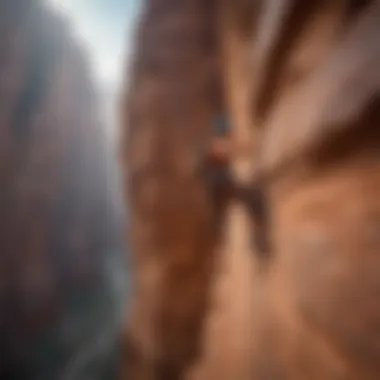
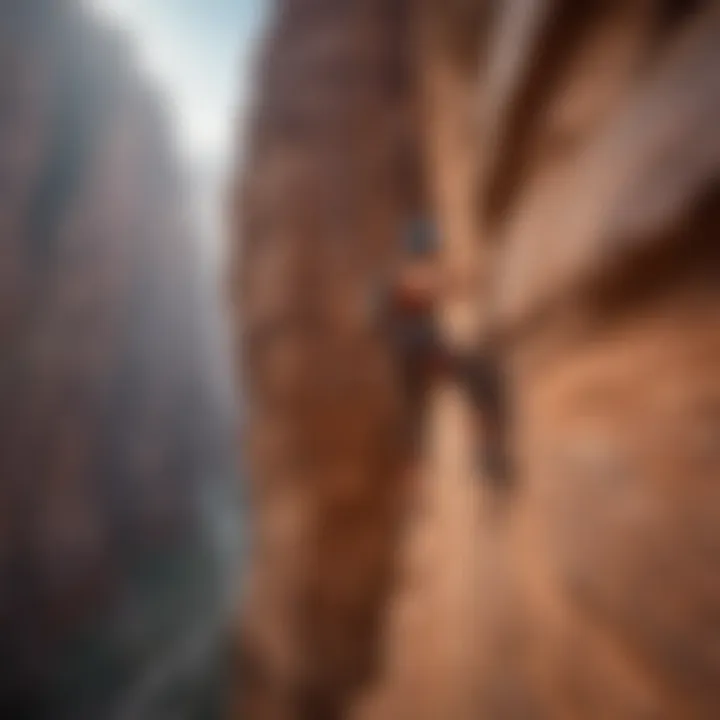
Featured Sport of the Month
Rock climbing is often featured in discussions about extreme sports. This month, climbers are encouraged to focus on their mental preparedness and strategies to overcome psychological barriers. Mental resilience is as crucial as physical strength in this demanding sport.
Profiles of Prominent Athletes
Gaining inspiration from others can motivate climbers. Athletes like Adam Ondra andAlex Honnold push boundaries in climbing, showcasing what is possible in the sport. Their journeys reflect dedication and continuous learning.
"The best climber in the world is the one having the most fun." - Alex Honnold
Overview of Petra as a Climbing Destination
Petra, often referred to as the "Rose City," is famed not only for its archaeological significance but also for its unique role as a climbing destination. This ancient site draws thrill-seekers and adventure enthusiasts from around the globe. The combination of stunning landscapes and challenging terrain elevates Petra to a premier location for rock climbing. This article will delve into the aspects that make Petra a notable destination for climbing, emphasizing its historical and geological significance.
Historical Importance of Petra
Petra has a rich history that dates back to the Nabateans, who established it as a thriving trade hub. This historical context adds depth to the climbing experience. Climbers are not just scaling rocks; they are engaging with a site that has witnessed centuries of human activity. The remains of ancient structures carved into the sandstone provide a striking backdrop, enhancing both the aesthetic and cultural value of the journey.
Historic routes carved by past civilizations can also serve as indicators for modern climbers, revealing how the topography influenced historic settlement patterns and trade routes. Exploring Petra's climbing landscape allows for a deeper appreciation of its cultural heritage, making each ascent a blend of adventure and historical exploration.
Geological Features of Petra
The geological features of Petra are what truly set it apart as a climbing destination. The region is primarily composed of sandstone, which creates various climbing opportunities due to its unique rock formations. The weathered cliffs and talus slopes provide a varied terrain that can cater to different climbing styles, from sport climbing to traditional techniques.
The intricate layers of rock tell a story of geological processes over millions of years. Climbers can find everything from overhangs to vertical faces, offering challenges that require a range of techniques. Furthermore, the area's climate can also affect climbing conditions, with seasons bringing about changes in rock stability and accessibility.
In summary, Petra's standing as a climbing destination is not just about the climbing itself, but also about the historical and geological narratives that intertwine with the sport. Understanding these aspects is essential for climbers looking to fully immerse themselves in the experience.
Climbing Techniques Specific to Petra
The climbing techniques specific to Petra are crucial for understanding how climbers can navigate this unique environment effectively. The intricate rock formations, along with the various geological features, create a distinct climbing landscape that requires specialized skills. When exploring Petra, climbers must adapt their techniques to meet the challenges of the terrain. This adjustment is not only about making the ascent easier but also about ensuring a safe and enjoyable experience in this historical marvel.
Understanding Rock Formation
Petra’s rock formations include sandstone cliffs, narrow canyons, and expansive plateaus. Each feature offers different climbing opportunities and challenges. Sandstone, known for its layered construction, can be both forgiving and unforgiving. At times, it provides strong holds and traction; at other times, it can crumble if not handled properly. It is essential for climbers to study the rock types and their structural integrity before attempting a route. Understanding these geological aspects can greatly influence climbing strategies and safety measures.
Climbing Styles Utilized
Climbing in Petra encompasses a variety of styles, each with its significance and application.
Sport Climbing Techniques
Sport climbing is one of the predominant styles in Petra due to the availability of routes that are bolted for protection. This technique allows climbers to focus on the physical aspects of climbing without the constant worry about traditional gear placement. Sport climbing utilizes fixed anchors and draws, which provide a safety net for falling climbers. Its popularity stems from the accessibility of well-established routes that cater to various skill levels.
However, while sport climbing offers benefits such as easier gear management and quicker route assessments, it also disadvantages climbers unfamiliar with managing dynamic falls or route finding. Climbers must be mindful of their route planning to ensure a safe experience.
Traditional Climbing Approaches
Traditional climbing, often referred to as trad climbing, is characterized by the use of removable protection, such as camming devices and nuts. This style allows climbers to establish their own anchors, making it crucial in areas where fixed protection is sparse. Traditional climbing is a beneficial choice in Petra, as many areas do not have bolted routes, and the rock structure lends itself to this method of protection.
The autonomy offered by trad climbing fosters a deep connection between a climber and the rock face. However, it also demands a higher level of skill and judgment. Climbers must be capable of assessing rock quality and making quick decisions on how to protect themselves as they ascend.
Bouldering Specifics
Bouldering involves climbing shorter walls without the use of ropes, relying on crash pads for safety. In Petra, bouldering can be especially enticing due to the boulders scattered throughout the site, providing unique challenges. It’s a beneficial style for those looking to focus on technique and strength without the complexities of gear.
One unique feature of bouldering is the ability to practice climbing sequences on the ground. This method allows climbers to break down moves and mentally rehearse their approach before tackling a route. However, the challenge lies in the lack of height, meaning any fall can have more serious consequences if not approached with caution.
In summary, mastering the climbing techniques in Petra requires a thorough understanding of the varied rock formations and adaptive strategies for different styles. Understanding the nuances of sport climbing, traditional climbing, and bouldering allows climbers to navigate this UNESCO World Heritage site efficiently, all while respecting its cultural significance.
Essential Gear for Climbing in Petra
When considering climbing in Petra, the right gear is not just a preference; it is essential. The unique geological characteristics and demanding climate of this ancient site challenge even the most experienced climbers. Selecting appropriate equipment can significantly enhance safety, performance, and enjoyment during your climbing adventure.
Climbing Harness and Ropes
A well-fitted climbing harness is arguable the most critical piece of gear for any climber. It serves as a lifeline, connecting you to the climbing rope and ensuring your safety during ascents. In Petra, where rock conditions may vary sharply, having an adjustable harness that fits securely can prevent accidents. Look for harnesses designed with padded leg loops for comfort during prolonged wear.
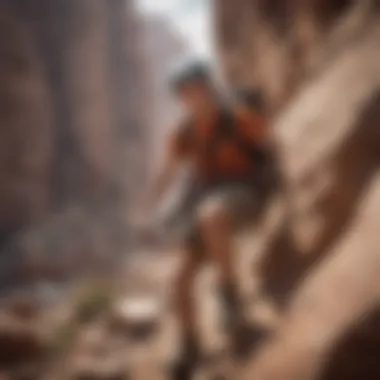
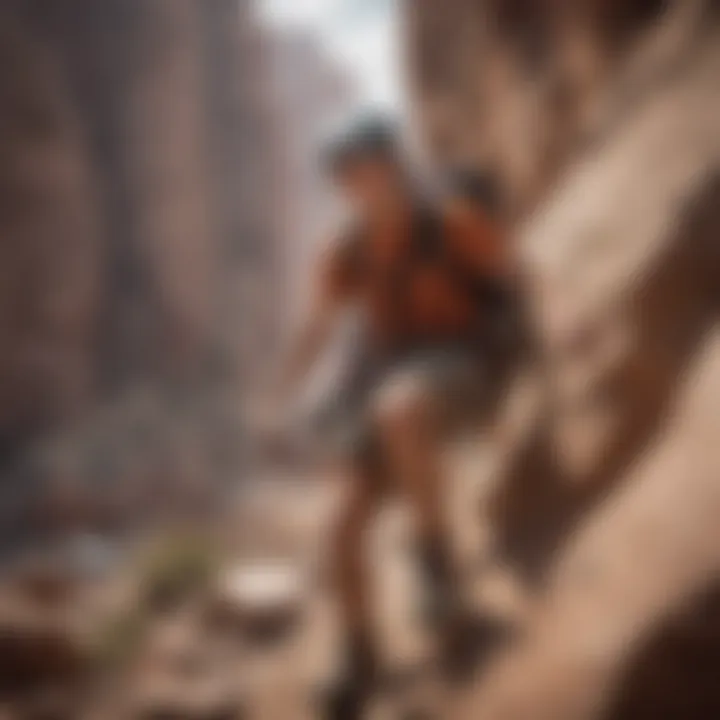
When it comes to ropes, choosing dynamic ropes is crucial. They can stretch under load, absorbing the force of a fall. Generally, a rope length of 60 meters is standard, but consider carrying longer ropes to accommodate Petra's unique climbing routes. Ropes with a diameter between 9.5mm and 10.5mm provide a useful balance between durability and weight.
Footwear Considerations
Climbing shoes are not just about grip; they influence your footwork significantly. In Petra, the rock can be abrasive and routes may have unforeseen characteristics. Thus, climbing shoes should have a snug fit without sacrificing comfort. Opt for shoes with a sticky rubber sole that can adapt to various rock surfaces. Look for a model with moderate asymmetry for better performance on multi-pitch climbs.
In addition to standard climbing shoes, consider bringing approach shoes. These provide support for hiking to climbing sites and offer comfort during long walks on rugged terrain.
Climbing Protection and Safety Gear
Protection systems in climbing serve to secure you in case of a fall and are especially significant in an area like Petra with its unique rock formations. Gear like quickdraws, cams, and nuts are the frontline equipment for traditional climbs. Make sure you have a selection to cover different cracks and features found in Petra. The importance of well-maintained gear cannot be overstated; regularly check your gear for signs of wear or damage.
In addition, a climbing helmet is necessary in Petra to protect against falling debris or rock. Choose a lightweight, well-ventilated model that fits securely on your head.
Finally, a first-aid kit is a fundamental consideration. Since Petra is remote, ensure your kit includes items like bandages, antiseptic wipes, and any personal medication you might need in case of emergencies.
Safety Precautions While Climbing
Rock climbing at Petra offers thrill and adventure, but it is paramount to understand the importance of safety precautions. The unique geological formations and the extreme environment present various risks. Therefore, knowing how to assess these risks significantly increases climber safety and enjoyment.
Assessing Risks and Challenges
When assessing risks, climbers must evaluate the specific conditions of the Petra area. This includes weather conditions, rock stability, and personal skill levels. Factors that climbers should consider include:
- Weather: Sudden changes in weather can create hazardous conditions. Rain can make rocks slippery, while high winds can affect stability while climbing.
- Rock Quality: Inspect the quality of the rock. Certain sections may be prone to falling rocks or may have loose holds. Knowledge about the rock type will help identify potential hazards.
- Personal Skills: Climbers should honestly assess their own experience and fitness. Attempting routes that exceed one’s skill level can lead to dangerous situations.
Regularly updating knowledge about climbing techniques and ongoing education in safety practices, such as taking part in workshops or advanced climbing courses, helps climbers stay aware and prepared.
Emergency Protocols
Having emergency protocols in place gives climbers reassurance while they are in challenging environments like Petra. It is crucial to establish clear procedures for various situations. Key elements of these protocols include:
- Communication Plans: Before climbing, climbers should inform someone in the local area about their climbing plan, including expected return times.
- First-Aid Knowledge: Basic first-aid training is essential. Climbers should know how to address common injuries, like cuts or sprains, and how to manage more severe accidents until help arrives.
- Access to Emergency Services: Knowledge of local emergency services, such as hospitals or mountain rescue teams, ensures swift response if necessary. Keeping a phone or device for communication is critical, but also be aware of poor signal areas.
- Group Coordination: If climbing in groups, establish clear roles and responsibilities for each member during an emergency. This can help in coordinating efforts more effectively.
"Preparation and knowledge are the best defenses against accidents. Always be ready for the unexpected."
A successful climbing experience in Petra does not only rely on skill but requires a comprehensive understanding of safety precautions. Adhering to these guidelines allows for more enjoyable climbs while minimizing risks.
Environmental and Cultural Considerations
The intersection of rock climbing and cultural sensitivity is critical in Petra. Understanding how climbing activities influence the environment and local communities is essential for maintaining the integrity of this UNESCO World Heritage site. As interest in rock climbing increases in Petra, climbers and enthusiasts must navigate the delicate balance between adventure and preservation.
Conservation Efforts in Petra
Conservation in Petra is not just a matter of preserving natural landscapes; it encompasses protecting historical artifacts and ancient structures as well. Here are some essential elements of the conservation efforts in the area:
- Sustainable Climbing Practices: Climbers should minimize their impact on the environment by following established routes and avoiding sensitive areas. Over the years, climbing has altered certain rock formations; thus, efforts to maintain climbing areas are crucial.
- Wildlife Protection: The ecosystem in Petra hosts unique flora and fauna. It is vital for climbers to refrain from disturbing wildlife habitats during their expeditions. Being mindful of animal life helps sustain biodiversity.
- Awareness Campaigns: Local organizations are working to educate climbers about the potential hazards their activities may pose to the environment. These campaigns often encourage responsible climbing behavior and promote conservation.
Ongoing initiatives strive to ensure that Petra remains a viable climbing destination while safeguarding its invaluable heritage.
"Climbing is an unparalleled way to connect with nature, but we must remember to tread lightly." – Anonymous climber
Respecting Local Culture
When climbing in Petra, it is imperative to recognize and respect the cultural heritage of the local Bedouin communities. Here are several guidelines that can promote cultural sensitivity:
- Engage with Local Customs: Learn about the traditions and lifestyles of the Bedouins. Simple gestures, like greeting local people in their language or participating in cultural events, can foster goodwill.
- Support Local Businesses: Choosing to buy gear, food, or guided tours from local vendors helps uplift the community. This not only boosts the economy but also cultivates mutual respect.
- Cultural Preservation: It is vital to avoid climbing on sacred sites or historical monuments. Respecting these places honors the cultural significance they hold for the local population.
While climbing in Petra is exhilarating, being mindful of its cultural dimensions enriches the experience for everyone involved.
Local Climbing Community and Resources
The local climbing community in Petra plays a crucial role in shaping the experience of climbers. The connections formed within this community enhance opportunities for adventure, safety, and cultural exchange. By understanding the dynamics of local activism and social networks, one can appreciate why they matter profoundly for both casual climbers and seasoned experts.
Guided Climbing Experiences
Guided climbing experiences in Petra are tailored to meet varied skill levels. Professional guides offer valuable insights regarding the area's specific rock formations, weather conditions, and local customs. Engaging a guide can significantly improve safety, especially in unknown terrains.
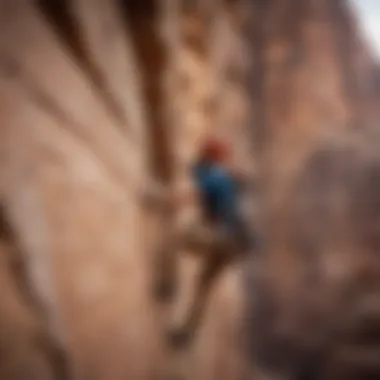
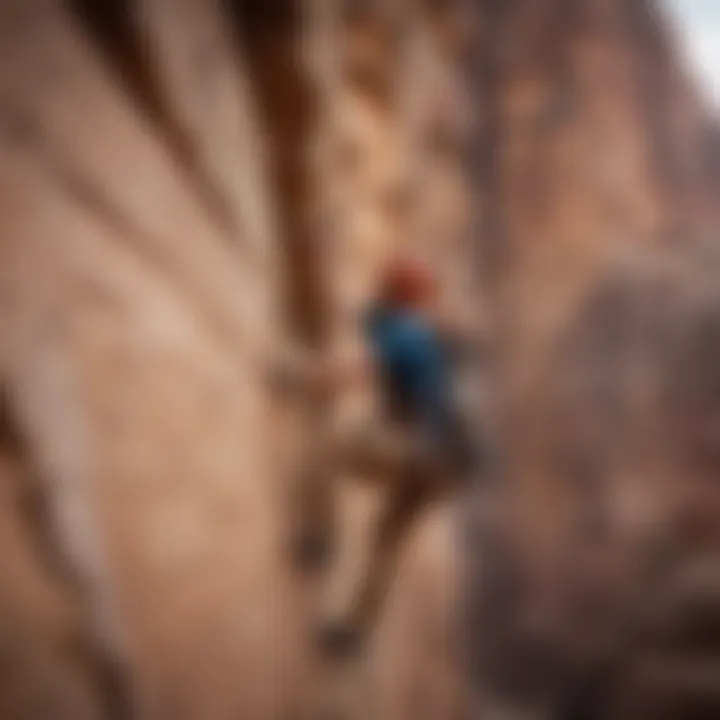
These guided experiences often provide:
- Local knowledge: Guides understand Petra's unique climbing requirements. They can direct climbers to suitable routes according to their skills.
- Safety measures: With their experience, guides ensure climbers use the right techniques and gear to navigate challenges effectively.
- Cultural immersion: A guide can also share the history and significance of the local area, enriching the climbing experience while promoting respect for the heritage.
Exploration under skilled supervision allows climbers to focus on technique and enjoyment without the burden of excessive worry about risks. Therefore, it is advisable to seek guided experiences when planning a climb in this historically rich environment.
Climbing Clubs and Organizations
Climbing clubs and organizations in Petra serve as pivotal connections for climbers seeking community and support. These networks not only facilitate climbing opportunities but also promote environmental conservation, education, and collaboration among climbers.
Benefits include:
- Networking opportunities: Clubs provide a platform for climbers to meet and share experiences, leading to potential partnerships for future climbs.
- Workshops and training: Many clubs organize events focusing on skills development, safety protocols, and sustainable climbing practices, which are essential for preserving Petra's delicate environment.
- Event coordination: These organizations often coordinate local competitions and gatherings, fostering a sense of camaraderie and competition among climbers.
Local clubs also prioritize ethical climbing practices, ensuring that the unique geological features of Petra are respected. Joining a club or following their events allows climbers to stay updated about best practices and responsibly enjoy the sport while being an active member of the community.
Personal Experiences and Testimonials
The section of personal experiences and testimonials serves as a vital component of understanding rock climbing in Petra. These firsthand accounts provide insights that cannot be captured through mere technical descriptions or equipment lists. When climbers share their stories, they illuminate the unique challenges and triumphs faced while navigating Petra's diverse climbing routes. This narrative depth enhances a reader's ability to connect emotionally with the experience and inspires others to explore this remarkable destination.
Interviews with Climbers
Interviews with climbers reveal diverse perspectives on the Petra climbing experience. Each climber brings individualized narratives, shaped by their background, skill level, and motivations. In these conversations, climbers often discuss their preparation for tackling Petra’s striking sandstone cliffs, emphasizing mental and physical conditioning.
A common theme among climbers is the allure of Petra’s history and breathtaking scenery. They highlight how the combination of physical challenge and historical context transforms an ordinary climb into a profound journey. Experiences shared by climbers reflect not just personal achievements but also the spirit of adventure and camaraderie. Some climbers acknowledge the community surrounding Petra, noting that finding partners for climbs greatly enhances the experience.
For instance, one climber remarked, “The moment I reached the summit, the view took my breath away. It reminded me why I climb; to connect with nature and history.” Such testimonials underline the emotional rewards of climbing in Petra, creating an engaging narrative thread.
Documented Climbs and Their Challenges
Documented climbs in Petra present a wealth of information about the area’s technical challenges. Each route carries its own set of obstacles, often shaped by the intricate geological formations. Climbers frequently detail the specifics of their ascents, including gear used and maneuvers attempted. This documentation not only provides practical information for those aiming to climb in Petra but also serves as a record of the individual’s journey.
The challenges faced during these climbs can range from unexpected weather changes to difficult rock conditions. For example, a documented ascent of the ‘High Place of Sacrifice’ reveals how the environment can shift dramatically, necessitating quick adaptation. Climbers note that falling rocks and varied grip conditions can often test one’s skill and focus.
In essence, these documented climbs offer both technical insights and personal reflections. They illustrate the dual nature of climbing: as both a physical challenge and a personal adventure. Each account contributes to a larger narrative about what it means to climb in such a historically and geographically rich environment.
Important Insight: Personal experiences and documented climbs showcase not just technical climbing abilities, but also foster a deeper appreciation for where climbers stand, surrounded by the ancient wonders of Petra.
Climbing Competitions in Petra
Climbing competitions represent an integral aspect of Petra’s climbing culture, fostering a sense of community and pushing climbers towards their limits. These events serve not only as a showcase of skill but also elevate Petra as a globally recognized climbing destination. The competitions bring together climbers from various backgrounds, enhancing the sharing of techniques and experiences.
Overview of Local Championships
Local championships in Petra often highlight the unique climbing conditions found in the region. They encompass various categories, including sport climbing and bouldering competitions. These events typically take place during the spring and autumn, when the weather is moderate, ensuring climbers can perform at their best.
Competitions attract both local and international athletes, fostering an environment of growth and camaraderie among climbers. Climbers must navigate the distinctive rock formations and challenging routes that Petra is famous for. This aspect of the competitions helps climbers adapt to Petra’s specific climbing style, which can be vastly different from other locations.
In addition, championships often include workshops and seminars led by experienced climbers, which serve to educate newcomers about safety practices and climbing techniques. Such interactions not only advance individual skills but also deepen the respect for the local climbing community.
Global Recognition of Petra Climbs
The climbs in Petra have gained a reputation on the global stage due to their unique characteristics and historical significance. Events such as the Petra Climbing Festival present the perfect opportunity for climbers to showcase their skills and compete against some of the best in the world.
The results of these competitions have significant implications. They transcend regional interest, attracting media coverage and sparking conversations within the world of extreme sports. Recognized climbers participating in local events can propel Petra into climbing guides and resources around the globe, thereby promoting tourism and inspiring new climbers.
Future Directions in Petra Climbing
In the evolving landscape of rock climbing in Petra, understanding future directions carries significant value. The unique geological formations and environmental challenges necessitate ongoing adaptations in climbing practices and gear. Furthermore, integrating cultural awareness into climbing practices will ensure that Petra remains not only a premier climbing destination but also a respected one.
Emerging Trends and Innovations
The world of rock climbing is not static; it continually embraces new trends and innovations that enhance the experience for climbers. One notable trend is the growth of eco-friendly climbing gear. Manufacturers are beginning to utilize sustainable materials to produce harnesses, ropes, and shoes, reducing the impact on the surrounding environment. Additionally, training programs increasingly emphasize conservation education, which encourages climbers to act with more awareness.
Moreover, the expansion of guided tours featuring experienced climbers is also evolving. These tours adapt to various skill levels, providing novices with the necessary skills while challenging experts with advanced routes. Such inclusivity fosters a sense of community and encourages shared experiences among climbers.
The Role of Technology in Climbing
Technology plays an undeniable role in modern climbing practices. Innovative gear is continually developed to improve safety. For example, smart helmets equipped with sensors can detect hights and help climbers assess risks. These advancements not only enhance safety but also foster a more informed climbing culture.
Moreover, mobile applications dedicated to climbing can provide digital maps, route information, and real-time weather updates. This information is crucial for climbers looking to navigate Petra's unique landscape efficiently. Networking platforms allow climbers to share experiences and tips in real-time, further enriching the climbing community.
In summary, the future of Petra climbing is shaped by trends in sustainability, inclusivity, and technology. As climbers become more aware of their environmental impact, they will continue to seek innovative solutions that not only enhance safety but also honor the legacy of this remarkable destination.







